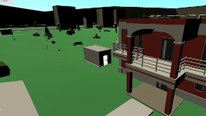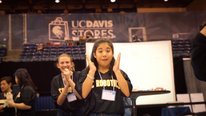NSF Awards: 1503451
The “Conceptual Model-based Problem Solving (COMPS): A Response to Intervention Program for Students with Learning Difficulties (LDs)” is an NSF funded project. This project is to create a cross-platform COMPS intervention program to address the burning needs of second- and third-grade students with LDs in meeting the challenging curriculum standards for Mathematics—particularly in the area of additive word problem solving. The objectives of this COMPS project include:
- Create the curriculum content and screen design for four modules of the COMPS program in the area of additive word problem solving (COMPS-A);
- Design and develop the cross-platform COMPS-A computer application that can be ported as web-based, iPad, Android, or windows app, which can run on different kind of computers and be accessible to students with various social economics status in a range of environment;
- Conduct field-test studies to evaluate the potential of the program in enhancing students’ word problem-solving performance.
This COMPS-A program represents a shift from traditional problem-solving instruction, which focuses on the choice of operation for solution, to a mathematical model-based problem-solving approach that emphasizes an understanding and representation of mathematical relations in algebraic equations and therefore promotes generalized problem-solving skills. This project is expected to make a broader impact due to (a) its emphasis on concept formation and additive reasoning and problem solving, which would benefit students with LDs as well as average or below average performing students, and (b) this tool’s flexibility with group or one-on-one instruction in and out of the classroom settings.









Yan Ping Xin
Professor
Welcome to our NSF supported COMPS-RtI project showcase video! Your favorable voting is appreciated! We welcome your constructive/insightful feedback and comments—Thank you!
Yan Ping Xin
Professor
As I am currently traveling in China and I may not have access to this website, my responding to your posts may be delayed. Thank you for your patience!
Yan Ping Xin
Andrew Izsak
Sybilla and I were intrigued by parallels with our own work in multiplication. You use a single mathematical model equation to represent diverse problem types, and you distinguish the original model from the equation that computes the solution. We do something similar in the context of multiplication when working with future middle and secondary grades mathematics teachers.
Yan Ping Xin
Professor
I am thrilled to hear that you and Sybilla’s work in multiplication is parallel to our work. In fact, Sybilla and I were presenting in the same working group at ICMI Study 23 in Macau. We are looking forward to learning from you and Sybilla’s work.
Wendy Smith
Associate Director
Your project looks very interesting. Does your program have a feature that reads the problems aloud for students for whom reading is difficult (either through learning disabilities, non-native English speakers, or other reading issues)? What kinds of support are there for teachers and students to learn to use your software? How successful do you find it to teach students the language of different problem types (such as part-part-whole)?
Yan Ping Xin
Professor
Thank you for your interest in our work. Yes, we do have the feature that reads the problems aloud for students. In fact, most part of the tutoring is realized through on screen display/animation along with the voice output.
Towards the end of the project, we will develop a teacher’s manual to go along with this COMPS-RtI tutoring program so that the teachers, who use this program, will understand the underpinning theoretical framework as well as the tasks /skill sets addressed in each of the four modules of this tutoring program. In addition, general tips /guidelines for using the program will also be included in the teacher’s manual.
Whenever possible, we take advantages of the computer technology to create visual animations to go along with the voice/language so that the learners understand the meaning of the language we use to describe the concept of “part and part makes up the whole” as well as key mathematical concepts (e.g., the concept of composite unit) and vocabulary (e.g., “less than,” “more than”).
I hope above answer is helpful.
Wendy Smith
Associate Director
One other question that occurred to me: I wonder about your program's use of the "smaller" and "bigger" language attached to the part/whole. I understand what you are using it, but this is also a rule that "expires" as students begin to grapple with integers later. How does your project address the fact that you are teaching students something that will not be true later?
Yan Ping Xin
Professor
The concept of “Part and part makes up the whole” will not expire. We are not necessarily teaching the rule of “addition makes bigger.” The use of the words “smaller” and “bigger” is only to help students understand the mathematical relations described in additive comparison word problem stories. In particular, when two units (i.e., the compared, and the referent unit) are being compared, it is important for students to understand who (which unit) has “more” or who has “less.” Given the “part + part = whole” model equation, the one who has “more” will always be represented or placed on one side of the equation by itself—which is comparable to the “Whole”; the one who has “less” will be considered as one of the parts, which will be placed on the other side of the equation along with the difference quantity. That is, “smaller quantity + difference quantity = bigger (larger) quantity.”
I hope this helps to address your concern.
Miriam Sherin
Professor, Associate Dean of Teacher Education
Providing students with new ways to explore relationships among quantities and to model these relationships is an important goal. I appreciate the work your project is doing to support this! I'm wondering if you can say more about how you imagine the materials being used by students. Do you expect this will be something that students use on their own? Will it supplement or replace curriculum materials? I'm also wondering what part of the materials in particular you think are valuable for students with learning difficulties. It seems to me that the modeling approach has the potential to also strengthen the math understandings of students who do not have difficulty with more procedural approaches.
Yan Ping Xin
Professor
First of all, thank you for your positive and insightful comments!
To answer your question—
Students will not be expected to work with the tutor completely alone. Teacher has a synergistic role in this process. That is, In case the learner is “stuck” in the program, the teacher will be called upon for help. Upon request, the computer program will provide the teacher with a brief report that indicates the task the learner is current working on as well as recent interaction/exchanges between the learner and the tutor—the information from the report will help the teacher identify the issue and make proper diagnostic decisions. The teacher will either redirect the learner to the proper module/lesson or provide remediation to address skill deficit or misconception so that the learner can continue in the tutoring program.
The Teacher’s Manual we will produce upon completion of the project will prepare the teacher for the use of this COMPS-RtI tutor. Re the Teacher’s Manual, please also refer to my answer to Wendy’s first question above. Thank you!
As this program is in line with elementary mathematics curriculum standards, this tutoring program not only can be used as a supplemental program for students with learning difficulties in mathematics, but also can be used as a tool to help math teachers’ teaching to meet the regular curriculum standards.
Miriam Sherin
Professor, Associate Dean of Teacher Education
Thanks for this information. I'm wondering a bit about how easy it will be for teachers to review recent exchanges and then know how to proceed. If there are typical approaches you expect students to use perhaps that would be useful for teachers to have some information about?
Yan Ping Xin
Professor
Thank you so much for your insightful question/suggestion!
The Teacher’s Manual that the team will develop towards the end of the project will prepare the teacher with the knowledge in terms of "know how to proceed". Specifically--
If it is technical glitches, it is easy to be resolved—students will be monitored so that they follow the proper direction of the program.
If it is conceptual deficits, the “node map” for each of the modules (which will be developed as part of the Teacher’s Manual) will help the teacher make decisions in terms of whether the student should be sent back to a specific module or lesson to make up the prerequisite skill/knowledge or whether the student should bypass a specific skill (e.g., use a calculator rather than mental math to solve for the unknown quantity).
I hope above explanation is helpful.
Further posting is closed as the showcase has ended.